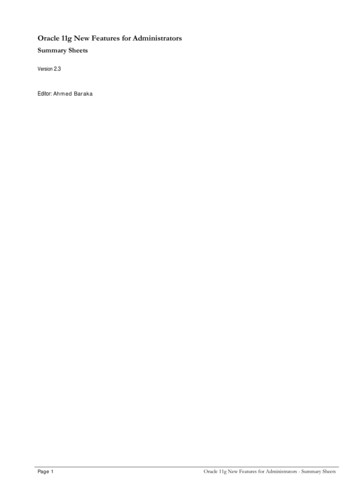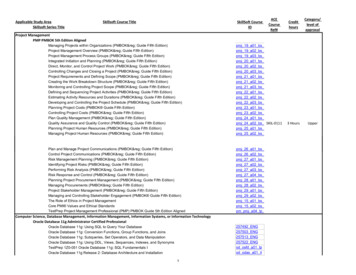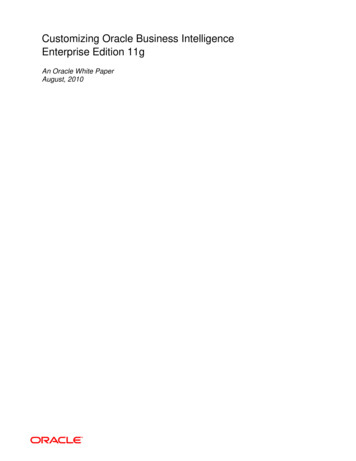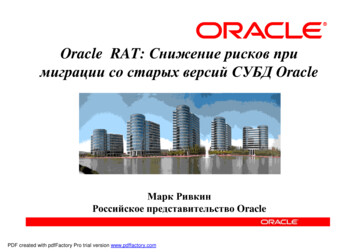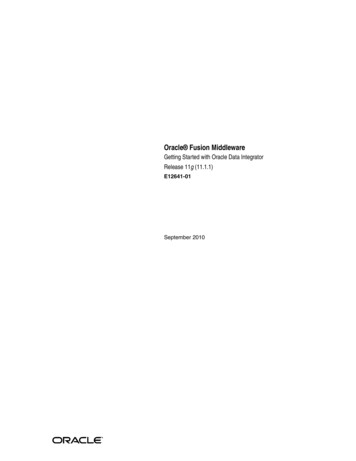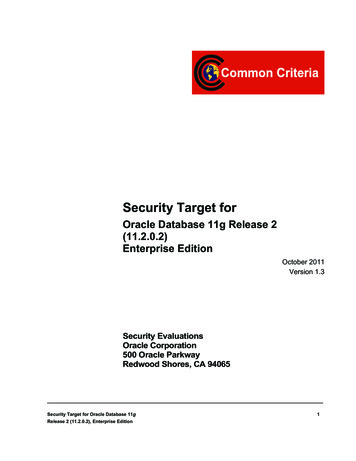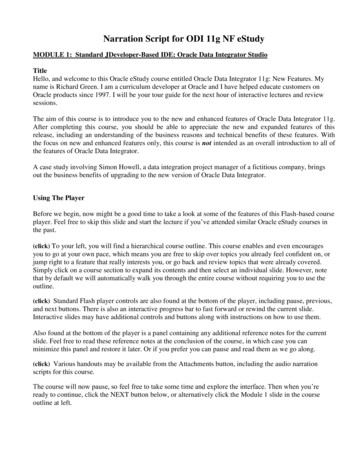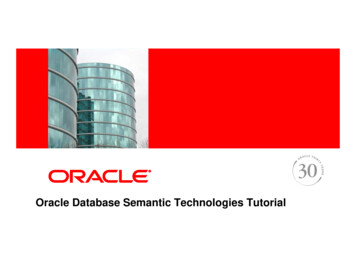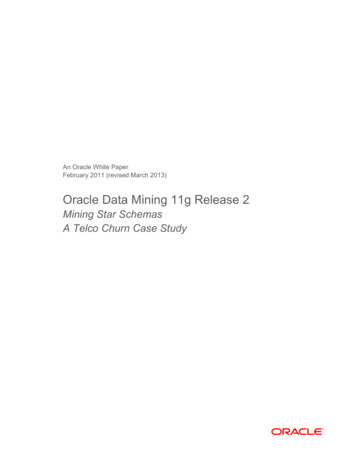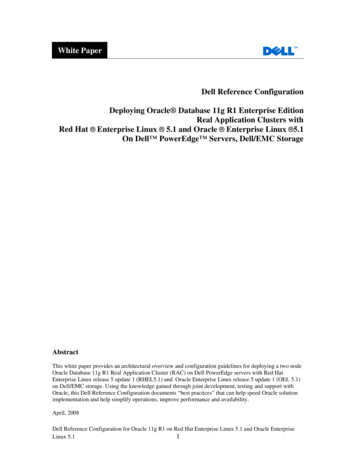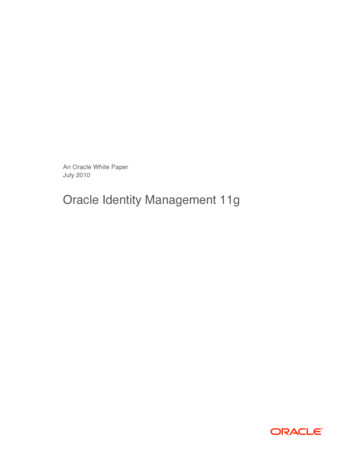
Transcription
An Oracle White PaperJuly 2010Oracle Identity Management 11g
Oracle White Paper—Oracle Identity Management 11gDisclaimerThe following is intended to outline our general product direction. It is intended for information purposesonly, and may not be incorporated into any contract. It is not a commitment to deliver any material, code, orfunctionality, and should not be relied upon in making purchasing decisions. The development, release, andtiming of any features or functionality described for Oracle’s products remains at the sole discretion ofOracle.
Oracle White Paper—Oracle Identity Management 11gIntroduction to Oracle Fusion Middleware 11g. 1Purpose and Scope. 2Oracle Identity Management Overview . 4Oracle Identity Management Business Benefits . 4Introducing Oracle Identity Management 11g . 6Service-Oriented Security . 6Oracle Identity Managementʼs Key Services . 7Oracle Identity Management Components. 12Platform Security Services . 12Directory Services . 23Access Management . 29Identity Management, Identity Access and Governance. 43Operational Manageability . 49Identity-As-A-Service . 51Oracle Identity Management and Other Oracle Technologies . 55Oracle Identity Management and Enterprise Governance . 55Oracle Identity Management and Oracle Database . 56Conclusion . 57
Oracle White Paper—Oracle Identity Management 11gIntroduction to Oracle Fusion Middleware 11gOracle Fusion Middleware (OFM) 11g provides a unified, standards-based infrastructureallowing customers to develop, deploy, and manage enterprise applications. OFM 11gextends Oracleʼs vision of delivering a complete, integrated, hot-pluggable, and best-ofbreed middleware suite based on Oracle WebLogic Server, the industryʼs leadingapplication server.Figure 1: Oracle Fusion Middleware 11g ComponentsOFM 11g enables a new level of agility and adaptability in enterprise applications bydelivering on the promise of service-oriented architectures (SOA). OFM 11g providesdevelopers and business users with a declarative toolset to design and roll out enterprise1
Oracle White Paper—Oracle Identity Management 11gapplications; a business process platform to orchestrate and monitor applications atruntime; and an enterprise portal allowing easy user interaction and secure access tocorporate and business partnersʼ resources. In addition, OFM 11g enhances middlewareservices in terms of enterprise performance management, business intelligence, contentmanagement, and identity management (the subject of this document).OFM 11g greatly increases the efficiency of modern data centers by extending thecapabilities of application grids. OFM 11g leverages the benefits of new hardwaretechnologies such as 64-bit architectures, multi-core processors, and resourcevirtualization to provide high-performance, pooled Internet services (commonly known as“cloud computing”) that are easier to deploy, integrate, and manage.Finally, OFM 11g relies on Oracle Enterprise Manager to provide a completemanagement solution in a single console. Oracle Enterprise Manager automaticallydiscovers all OFM components and their interdependencies and provides industry bestpractices built into dashboards for systems, services, and compliance.Purpose and ScopeThis document focuses on Oracle Identity Management 11g.As part of Oracle Fusion Middleware, Oracle Identity Management provides a unified,integrated security platform designed to manage user identities, provision resources tousers, secure access to corporate resources, enable trusted online businesspartnerships, and support governance and compliance across the enterprise.Oracle Identity Management ensures the integrity of large application grids by enablingnew levels of security and completeness to address the protection of enterpriseresources and the management of the processes acting on those resources.2
Oracle White Paper—Oracle Identity Management 11gOracle Identity Management provides enhanced efficiency through a higher level ofintegration, consolidation, and automation, and increased effectiveness in terms ofapplication-centric security, risk management, and governance. Oracle IdentityManagement supports the full life cycle of enterprise applications, from development todeployment to full-blown production.This document is mainly intended for a line-of-business and Information Technology (IT)audience, including application developers and application development managers,security architects, and systems and security administrators.This document covers all the aspects of the identity services provided by Oracle IdentityManagement: directory services, identity administration, access control, platform and webservices security, identity and access governance, operational manageability, and serviceintegration within the identity management suite and with other Oracle and non-Oracleenvironments.3
Oracle White Paper—Oracle Identity Management 11g“Oracle has established itself as the IAM [Identity and Access Management] market leader due to its solid technology baseacross the IAM landscape and its compelling, aggressive strategy around what it refers to as application-centric identity.”Andras Cser, Forrester Research, Inc.Oracle Identity Management OverviewIn just a few years Oracle has established itself as the foremost identity and access management(IAM) vendor by providing an integrated, application-centric product portfolio unmatched by itscompetitors. Oracle’s ability to anticipate and meet customer demand through a savvycombination of key acquisitions and organic growth has turned the company’s identity and accessmanagement offering into the IAM market leader.Oracle Identity Management Business BenefitsOracle Identity Management allows enterprises to manage the end-to-end life cycle of useridentities across enterprise resources both within and beyond the firewall, independently fromenterprise applications. In other words, Oracle Identity Management’s application-centricapproach allows customers to clearly separate business logic from security and resourcemanagement, thus promoting development agility and lowering maintenance costs.Oracle’s strategy for identity and access management provides the following key benefits:Figure 2: Oracle Identity Management BenefitsComplete: Oracle Identity Management provides a comprehensive set of market-leading servicesincluding identity administration and role management; user provisioning and compliance; webapplications and web services access control; single sign-on and federated identities; frauddetection; strong, multifactor authentication and risk management; role governance and identity4
Oracle White Paper—Oracle Identity Management 11ganalytics, audit and reports. All Oracle Identity Management components leverage the productsuite’s best-in-class, highly scalable directory and identity virtualization services to maximizeoperational efficiency and ensure the highest levels of performance and availability.Integrated: Oracle Identity Management components can be deployed separately or together as anintegrated suite of identity services. The various components making up Oracle IdentityManagement are designed to work together to satisfy each identity management and accesscontrol requirement met throughout a business transaction. Oracle Identity Managementcomponents integrate seamlessly with Oracle applications such as human capital management(Oracle’s PeopleSoft), performance management (Oracle’s Hyperion), customer relationshipmanagement (Oracle’s Siebel), as well as other Oracle Fusion Middleware components such asOracle SOA, Oracle WebCenter, and Oracle Business Intelligence. Oracle Identity Managementintegrates with Oracle’s Governance, Risk, and Compliance platform to provide an enterprisewide governance solution. Oracle Identity Management leverages and integrates with OracleDatabase through its own directory and identity virtualization services, thus providing extremescalability and lower cost of ownership. Finally, Oracle Identity Management provides extensionsto Oracle Information Rights Management, closing the gap between identity management andcontent management.Hot-Pluggable: Oracle Identity Management’s standards-based suite of products is designed tosupport heterogeneous, multiple-vendor development and runtime environments, includingoperating systems, web servers, application servers, directory servers, and database managementsystems. For example, XML standards for federation (e.g., Security Services Markup Language –SAML and WS-Federation) allow Oracle Identity Management components to support both inhouse, mission-critical applications (e.g., Java-based service providers) and third-party packagedapplications (e.g., Microsoft .NET-based accounting or project management systems), thusoptimizing past and future IT investments.Best-Of-Breed: In addition to Oracle Identity Management’s level of completeness, integration, andhot-pluggability, the components of the suite deliver functional depth and sophistication that,taken individually, makes them market-leading, best-of-breed products. Customers, especiallythose looking for advanced capabilities to support their application grid, can choose the best-inclass Oracle Identity Management component to meet their specific requirements and integratethat component with the rest of their existing identity management portfolio, or they can deploythe best-of-breed Oracle Identity Management suite to take advantage of its enhancedintegration.Oracle Identity Management is an integral part of Oracle Fusion Middleware. It leverages OracleFusion Middleware’s services such as Business Intelligence, Enterprise Management, and SOAand Process Management, and it provides security services to multiple Oracle Fusion Middlewarecomponents and Oracle Fusion Applications.5
Oracle White Paper—Oracle Identity Management 11gIntroducing Oracle Identity Management 11gOracle Identity Management 11g is characterized by the following: Establishment of Oracle Identity Management as a security development platform (see theOracle Platform Security Services and Identity Governance Framework sections later in this document). Oracle Identity Management becomes Oracle Fusion Applications’ de facto securityinfrastructure. Enhanced integration between Oracle Identity Management’s components and other OracleFusion Middleware components, Oracle Applications, and third-party security providers. Enhanced functionality allowing easier environment deployments (e.g., wizards to guide usersthrough rapid deployment tasks, multi-level actionable dashboards for business users toanalyze compliance and risk indicators, and take remediation actions). Streamlined release synchronization and technology uptake between the various productsmaking up Oracle Identity Management.Service-Oriented SecurityKey to Oracle Identity Management 11g is the concept of Service-Oriented Security (SOS). SOSprovides a set of security services leveraged by Oracle Fusion Middleware components, as shownin the figure below.Figure 3: Service-Oriented SecurityOracle’s SOS applies Service-Oriented Architecture (SOA) principles to security in order topromote better design (industry-standard security “components”), deployment (appropriate levelof security applied where necessary), and management (through a single point of administration).SOS is built upon Oracle Platform Security Services (OPSS), a security development frameworkdescribed later in this document.6
Oracle White Paper—Oracle Identity Management 11gOracle Identity Management leverages SOS to provide “identity as a service.” Identity servicestake the functionality of an identity management solution that would otherwise be bolted ontoapplications and make the set of identity services available in a SOA environment. Applicationsfollowing SOA guidelines are able to leverage these services without any concern about howthese services are provided. Shared identity services enable enterprises to make identity areusable, standard, transparent, and ubiquitous part of their applications.Figure 4: SOA-Based Shared, Reusable ServicesOracle Identity Managementʼs Key ServicesOracle Identity Management 11g provides a comprehensive set of services as shown in Figure 5:Identity administration; access management; directory services; identity and access governance;platform security; operational manageability.Figure 5: Oracle Identity Management 11g Services7
Oracle White Paper—Oracle Identity Management 11gInstead of cobbling together a heterogeneous environment from diverse, separate products, eachservice (for example user on-boarding) works with other identity services through standardinterfaces to provide a complete, homogeneous environment.Figure 6: Oracle Identity Management ArchitectureAn SOA architecture allows each service to leverage the environment within and outside identitymanagement. For example, the workflow engine used in user provisioning approvals is the same,standards-based workflow engine used by Oracle SOA Suite. Likewise, the same standardcryptographic libraries are used throughout the identity management environment and otherOracle Fusion Middleware components.The following tables summarize Oracle’s identity services and products by category.Platform Security ServicesCOMPONENTSDESCRIPTIONCOMMENTSOracle Platform SecurityStandards-based, enterprise-grade frameworkSecurity foundation for Oracle FusionServices (OPSS)exposing security services through pluggableMiddleware: all Oracle Fusionabstraction layers.Middleware components and OracleOPSS provides the “service-oriented security”Fusion Applications “consume” theapproach for Oracle Identity Management.OPSS frameworkʼs services.Oracle Authorization PolicyOAPM is a graphical user interface console forOAPM is intended for customers relyingManager (OAPM)administering OPSS-based authorizationon Oracle Fusion Middleware productspolicies.based on OPSS, custom or in-houseapplications built with Oracle ADF, andnext-generation Oracle FusionApplications.8
Oracle White Paper—Oracle Identity Management 11gIdentity GovernanceOracleʼs IGF is designed to help enterprisesOriginally started by Oracle, IGF is anFramework (IGF)control how identity-related information (e.g.,open-source project hosted by Theattributes and entitlements) is used, stored,Liberty Alliance.and propagated between applications.Authorization API (OpenAz)Oracleʼs Authorization API provides a standardAuthorization API is a public projectinterface between an application and a generalstarted by Oracle. As part of OPSS, itauthorization service. It also provides anwill become the sole authorization APIeffective way to enable authorization providersfor Oracle Fusion Middleware.to plug in client-side authorization functionality.Oracle Web ServicesOWSM secures standards-compliant webStandards-based, policy-centricManager (OWSM)services (Java EE, Microsoft .NET, PL/SQL,security lynchpin for Oracle Fusionetc.), service-oriented architecture (SOA)Middleware web services.composites, and Oracle WebCenterʼs remoteportlets.Directory ServicesCOMPONENTSDESCRIPTIONCOMMENTSOracle Internet DirectoryEnterprise Lightweight Directory AccessHighly scalable LDAP directory(OID)Protocol (LDAP) directory server and directoryintegrated with Oracle Fusionintegration platform implemented on top ofMiddleware and Oracle FusionOracle Database technology providingApplications.unsurpassed level of scalability, highavailability, and information security.OID includes Oracle Directory ServicesManager (ODSM), a web-based administrationuser interface for server configuration.Oracle Directory ServerEnterprise identity services including the LDAPSmall-footprint, best-of-breed LDAPEnterprise EditionDirectory Server, Directory Proxy, Directorydirectory, recommended for(ODSEE)Synchronization, web-based managementheterogeneous applicationuser interface and deployment tools.deployments. Will be integrated withODSEE is the industryʼs leading, carrier-gradeODSM and Data Integration Platformdirectory.(DIP).Oracle Virtual DirectoryJava-based environment designed to provideOVD provides a single standard(OVD)real-time identity aggregation andinterface to access identity data notransformation without data copying or datamatter where it resides while hiding thesynchronization.complexity of the underlying dataOVD includes two primary components: theinfrastructure (OVD does not storeOVD Server to which applications connect,information, this role is left to theand ODSM (described above).persistence systems used for thatpurpose, such as OID and ODSEE).9
Oracle White Paper—Oracle Identity Management 11gAccess ManagementCOMPONENTSDESCRIPTIONCOMMENTSOracle Access ManagerOAM provides centralized, policy drivenOAM integrates with a broad array of(OAM)services for web applications authentication,authentication mechanisms, third-partyweb single sign-on (SSO), and identityweb servers and application servers,assertion.and standards-based federated SSOsolutions to ensure maximum flexibilityand a well-integrated, comprehensiveweb access control solution.Oracle Identity FederationOIF is a self-contained solution enablingOIF seamlessly integrates with third-(OIF)browser-based, cross-domain single sign-onparty identity and access managementusing industry standards (SAML, Liberty ID-FF,solutions.WS-Federation, Microsoft WindowsOIF is specifically designed for identityCardSpace).providers.A lightweight federation extension allowing aOracleʼs Fedlet is specifically designedservice provider to immediately federate withfor service providers and fullyan identity provider without requiring a full-integrated with OIF.Oracle OpenSSO Fedletblown federation solution in place.Oracle OpenSSO SecurityOracleʼs STS establishes a trust relationshipSTS is currently available with theToken Service (STS)between online partners through web services.Oracle Access Management Suite Plus.STS provides both standard and proprietaryGoing forward, Oracleʼs STS will besecurity token issuance, validation, andintegrated with OAM.exchange.Oracle Enterprise SingleOracle eSSO is a Microsoft Windows desktop-Using Oracle eSSO, enterprise usersSign-On (eSSO)based set of components providing unifiedbenefit from single sign-on to all of theirauthentication and single sign-on to both thick-applications, whether users areand thin-client applications with no modificationconnected to the corporate network,required to existing applications.traveling away from the office, roamingbetween computers, or working at ashared workstation.Oracle Entitlements ServerOES is a fine-grained authorization engine thatOES provides a centralized(OES)externalizes, unifies, and simplifies theadministration point for complexmanagement of complex entitlement policies.entitlement policies across a diverserange of business and IT systems.Oracle Adaptive AccessOAAM provides resource protection throughOAAM consists of components thatManager (OAAM)real-time fraud prevention, software-basedcreate one of the most powerful andmultifactor authentication, and uniqueflexible weapons in the war againstauthentication strengthening.fraud.10
Oracle White Paper—Oracle Identity Management 11gIdentity Management, Identity and Access GovernanceCOMPONENTSDESCRIPTIONCOMMENTSOracle Identity ManagerOIM typically answers the question "Who hasIn extranet environments, OIMʼs(OIM)access to What, When, How, and Why?". OIMsuperior scalability allows enterprises tois designed to administer both intranet andsupport millions of customersextranet user access privileges across aaccessing the companyʼs resourcescompany's resources throughout the entireusing traditional clients (e.g., browsers)identity management life cycle, from initial on-or smart phones.boarding to final de-provisioning of an identity.Oracle Identity AnalyticsOIA helps enterprises address regulatoryIntegrates with OIM for role(OIA)mandates, automate processes, and quicklyadministration and role-basedmake compliance a repeatable andprovisioning automation as part ofsustainable part of business. OIA provides aOracle remediation.comprehensive solution for attestation (accesscertification), role governance, and enterpriselevel segregation-of-duties enforcement.Operational ManageabilityCOMPONENTSDESCRIPTIONCOMMENTSOracle Identity NavigatorOIN is an SSO-enabled launch pad for all ofOIN acts as a user experience(OIN)Oracle Identity Management servicesʼconsolidation point for Oracle Identityadministrative consoles.Management.Oracle Management PackOracle Management Pack for IdentitySupport for service-level configuration,for Identity ManagementManagement leverages Oracle Enterprisedashboard-based user interaction,Manager's broad set of capabilities to controlenvironment monitoring, performanceend-to-end identity management components.automation, and patch management.Each Oracle Identity Management functional area is described in detail in the following sectionsof this document.11
Oracle White Paper—Oracle Identity Management 11gOracle Identity Management ComponentsOracle Identity Management’s areas of functionality presented in the previous section areimplemented by the multiple products described in this document. Details for each product areprovided in dedicated technical white papers (please visitoracle.com/technology/products/id mgmt/ to download Oracle Identity Management’scomponents information).Platform Security ServicesPlatform security services include the Oracle Platform Security Services (OPSS) framework,Identity Governance Framework (IGF), Authorization API, and Oracle Web Services Manager(OWSM).Oracle Platform Security ServicesOne of the key benefits and differentiators of Oracle Identity Management 11g is enhancedsupport for application development, provided by Oracle Platform Security Services (described in thissection) and the Identity Governance Framework and ArisID (described in the next section).Companies understand the necessity of including security as part of the development process,but they face challenges in implementing security in the various layers of multi-tiered webapplications.Figure 7: Oracle Platform Security ServicesOracle Platform Security Services (OPSS) provides enterprise product development teams,systems integrators, and independent software vendors with a standards-based, portable,integrated, enterprise-grade security framework for Java Platform, Standard Edition (Java SE)and Java Platform, Enterprise Edition (Java EE) applications.12
Oracle White Paper—Oracle Identity Management 11gOPSS insulates developers from the intricacies of tasks not directly related to applicationdevelopment by providing an abstraction layer in the form of standards-based applicationprogramming interfaces (API). Thanks to OPSS, in-house-developed applications, third-partyapplications, and integrated applications benefit from the same, uniform security, identitymanagement, and audit services across the enterprise.OPSS is the security foundation for Oracle Fusion Middleware: all Oracle Fusion Middlewarecomponents and Oracle Fusion Applications “consume” the OPSS framework’s services.OPSS is a self-contained, portable environment that runs on Oracle WebLogic Server. Atdevelopment time, OPSS services can be directly invoked from the development environment(Oracle JDeveloper) through wizards. When the application is deployed to the runtimeenvironment, systems and security administrators can access OPSS services for configurationpurposes through Oracle Enterprise Manager Fusion Middleware Control or command linetools.OPSS complies with the following standards: role-based-access-control (RBAC); Java Platform,Enterprise Edition (Java EE), Java Authorization and Authentication Services (JAAS), and JavaAuthorization Contract for Containers (JACC).OPSS includes Oracle WebLogic Server's internal security services used by BEA-heritageproducts such as Oracle Entitlements Server; these services are consumed by Security ServicesProvider Interface (SSPI), which becomes part of OPSS as well. In addition, OPSS includesOracle Fusion Middleware’s security framework (formerly referred to as Java Platform Security(JPS) or JAZN). SSPI provides Java EE container security in permission-based (JACC) mode and in resourcebased (non-JACC) mode. It also provides resource-based authorization for the environment,thus allowing customers to choose their security model. SSPI is a set of APIs designed toimplement pluggable security providers in order to support multiple types of security services,such as custom authentication or a particular role mapping. JPS was first released with Oracle Application Server 9.0.4 as a JAAS-compatibleauthentication and authorization service working with XML-based and Oracle InternetDirectory providers. In 11g, JPS has been expanded to include the following services(described later in this section): Credential Store Framework (CSF), User and Role API, OracleFusion Middleware Audit Framework, and JDeveloper/ADF integration (application securitylife cycle support).OPSS also includes Oracle Security Developer Tools (OSDT), a set of Java-based cryptographiclibraries supporting XML signature, XML encryption, XML Key Management Specification(XKMS), SAML, WS-Security, and other non-XML standards such as Secure / MultipurposeInternet Mail Extensions (S/MIME) and Online Certificate Status Protocol (OCSP).13
Oracle White Paper—Oracle Identity Management 11gOSDT is used in many Oracle products including Oracle applications and Oracle FusionMiddleware components. OPSS leverages OSDT for SSL configuration and Oracle Wallet (usedby Oracle Identity Management products, Oracle EM, and Oracle Database).OPSS provides out-of-the-box support for (1) applications using WebLogic Server’s internalsecurity and SSPI, such as Oracle Entitlements Server and Oracle Access Manager, and (2)applications using JPS, such as Oracle ADF, Oracle WebCenter, Oracle SOA, and Oracle WebServices Manager.Developers can use OPSS APIs to build security features for all types of applications andintegrate them with other security artifacts, such as LDAP servers, database systems, and customsecurity components. Administrators can use OPSS to deploy large enterprise applications with asmall, uniform set of tools and administer all security in them. OPSS simplifies the maintenanceof application security because it allows the modification of security configuration withoutchanging the application code.Figure 8: Oracle Platform Security Services ArchitectureOPSS’s functional layers include:Authentication: OPSS uses WebLogic Server authentication providers, components that validateuser credentials or system processes based on a user name-password combination or a digitalcertificate. Authentication providers include the Default Authenticator, external LDAP stores,and database systems to host data for enterprise applications.Identity Assertion: The WebLogic Identity Assertion providers support certificate authenticationusing X.509 certificates, SPNEGO tokens, SAML assertions, and CORBA Common SecureInteroperability version 2 (CSIv2) identity assertion.14
Oracle White Paper—Oracle Identity Management 11gSingle sign-on (SSO): Authentication providers can use different types of systems to store securitydata. The Authentication provider that WebLogic Server installs uses an embedded LDAPserver. Oracle Fusion Middleware 11g also supports perimeter authentication and SSO throughOracle Access Manager (OAM). For small environments that don’t need to be integrated with anenterprise SSO solution such as OAM, lightweight SSO is provided by a SAML-based solutionusing WebLogic Server’s SAML Credential Mapping Provider.Authorization: OPSS provides a Java policy provider that supports code-based and subject-basedauthorization.Note: A subject is a grouping of related security information that includes a collection of principals such as a name (“John Doe”),an email address (“jd@oracle.com”), together with (optional) security-related attributes (credentials) such as passwords orcryptographic keys. The Java class javax.security.auth.Subject represents a subject and an instance of this classis created and populated with principals when authentication succeeds. OPSS authentication providers enable identitypropagation across multiple components in a domain through subjects.OPSS supports application roles (logical roles specific to an application). Unlike Java EE’s logicalroles, OPSS supports role hierarchy. OPSS also provides an advanced policy model that includeselements such as resource types (e.g., an ADF task flow) and entitlement sets (authorized actionson a given resource instance) allowing complex authorization policies to be conveniently definedand managed. Using Oracle EM Fusion Middleware Control or WebLogic Scripting Tool(WLST), the administrator can manage an application’s authorization policies, including mappingapplication roles to enterprise groups and users, or editing the permissions granted to anapplication role. OPSS also provides a policy management API allowing programmatic controlover authorization policies.User and role: OPSS’s User and Role API framewo
Oracle Fusion Middleware (OFM) 11g provides a unified, standards-based infrastructure allowing customers to develop, deploy, and manage enterprise applications. OFM 11g extends Oracleʼs vision of delivering a complete, integrated, hot-pluggable, and best-of-breed middleware suite based on Oracle WebLogic Server, the industryʼs leading
